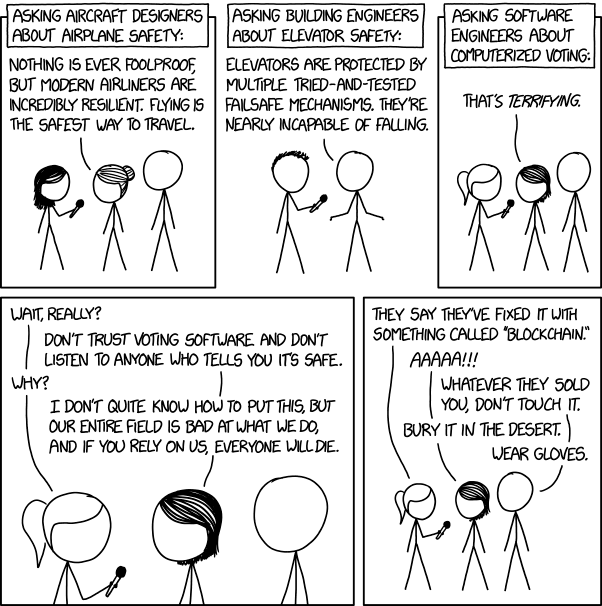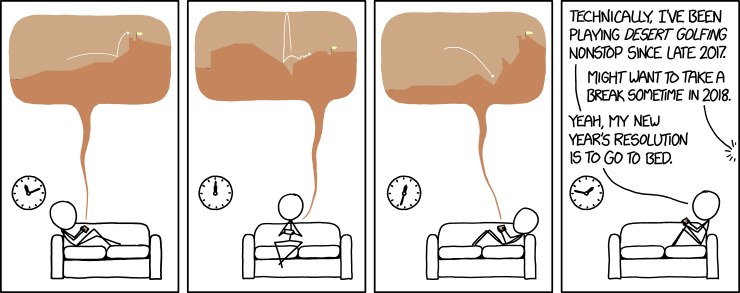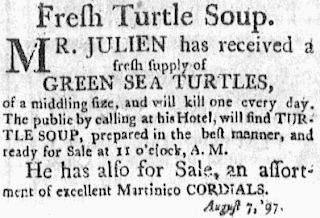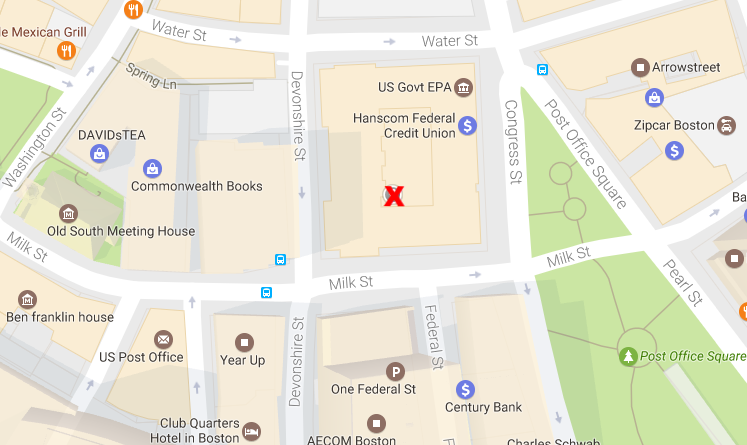

Amen!! Paper... paper... paper. It's simple. It's trivial to recount. Everyone already knows how to use it. It's cheap. It's verifiable. Just... use... paper.
13 public comments
endorsed; co-signed; it. me. &c.
(alt text: «There are lots of very smart people doing fascinating work on cryptographic voting protocols. We should be funding and encouraging them, and doing all our elections with paper ballots until everyone currently working in that field has retired.»)
(alt text: «There are lots of very smart people doing fascinating work on cryptographic voting protocols. We should be funding and encouraging them, and doing all our elections with paper ballots until everyone currently working in that field has retired.»)
South Burlington, Vermont
9 public comments
I was surprised to learn to that the likely first restaurant in America opened in in 1793 in what is now Boston’s Post Office Square.
I was further surprised to learn that the word “restaurant,” in the sense we now use it, is only a few years older, dating to Paris, 1765.
Prior to than, a “restaurant” wasn’t a place, but a meal – literally “a food that restores.”
By tradition, the restorative meal was usually some kind of soup – beef or chicken bouillon with roots and vegetables. (More info via links at the end of this text.)
But in 1765, a Parisian named Boulanger changed that. He owned a traditional bouillons restaurants near the Louvre, and wanted a way to differentiate his shop from others. So, he also began serving more substantial fare, such as leg of lamb. However, in the rigid society of pre-Revolution France, that type of food was supposed to be within the sole preview of the Caterers' Guild. Lawsuits ensued.
But – remember the times – the courts actually ruled in favor of the little guy, Boulanger, allowing him to offer a variety of food to his customers. Thus, his bouillons shop started down the road to something closer to the modern meaning of restaurant.
A few years later, with the French Revolution in full swing, one Jean Baptiste Gilbert Payplat dis Julien fled to Boston, bringing this idea of a new-style restaurant with him.
In Boston at that time, for ordinary folk, hot meals outside the home were usually obtained in inns, boarding houses, hotels, and such; or you could buy some food to accompany your ale or wine at the tavern. In any case, patrons generally ate whatever communal/public meal the kitchen currently had on the stove or in the oven. If you didn’t want what the kitchen was already cooking, you went someplace else, or you didn’t eat.
In 1793, when Julien opened “Julien's Restorator” – a restaurant with on-demand kitchen services offering a variety of foods – the idea was so new, he had to describe how it worked in his opening announcement in a Boston newspaper:
“… a Bill of Fare will be kept constantly for exhibition; from which each visitor may command whatever may best suit his appetite.”
The rest of his newspaper ad stressed the healthfulness and economy of his Restorator, including its “suitable nourishment” for the infirm; and appealed to Puritan sensibilities by carefully balancing the offered “excellent wines and cordials” with the promise that “all gaming [is] disallowed;” and of course, “no spirits.”
A few years later, people knew what the Restorator was, and his ads could focus on the current specials.
With that as background, I went looking for the site of the Restorator, originally on “Leverett’s Lane,” a street that no longer exists.
Wikipedia shows what the Restorator looked like, but without any surrounding landmarks or reference points:
I dug further, checking the Boston Public Library (not much info) and the Boston Atheneum which turned out to have, in its collection, an unfinished 1796 watercolor by Daniel Dearborn; it identifies the local buildings including – number 14 on the watercolor – Julien’s Restorator.
"Perspective view on the northward of Mr. Dearborn's School:" (low-res shown: see links at end for full-res version via the Atheneum site.)
Closeup:
Julien Hall was indeed on the corner of Milk and Congress Streets; roads that still exist in Boston, and the current location of the McCormack Post Office and Court House.
Or, zoomed in, about where the red X is here:
Current views: Looking west on Milk Street; the Restorator would have been somewhat towards the back, and under, the massive building on the right side of the street.


I was further surprised to learn that the word “restaurant,” in the sense we now use it, is only a few years older, dating to Paris, 1765.
Prior to than, a “restaurant” wasn’t a place, but a meal – literally “a food that restores.”
By tradition, the restorative meal was usually some kind of soup – beef or chicken bouillon with roots and vegetables. (More info via links at the end of this text.)
But in 1765, a Parisian named Boulanger changed that. He owned a traditional bouillons restaurants near the Louvre, and wanted a way to differentiate his shop from others. So, he also began serving more substantial fare, such as leg of lamb. However, in the rigid society of pre-Revolution France, that type of food was supposed to be within the sole preview of the Caterers' Guild. Lawsuits ensued.
But – remember the times – the courts actually ruled in favor of the little guy, Boulanger, allowing him to offer a variety of food to his customers. Thus, his bouillons shop started down the road to something closer to the modern meaning of restaurant.
A few years later, with the French Revolution in full swing, one Jean Baptiste Gilbert Payplat dis Julien fled to Boston, bringing this idea of a new-style restaurant with him.
In Boston at that time, for ordinary folk, hot meals outside the home were usually obtained in inns, boarding houses, hotels, and such; or you could buy some food to accompany your ale or wine at the tavern. In any case, patrons generally ate whatever communal/public meal the kitchen currently had on the stove or in the oven. If you didn’t want what the kitchen was already cooking, you went someplace else, or you didn’t eat.
In 1793, when Julien opened “Julien's Restorator” – a restaurant with on-demand kitchen services offering a variety of foods – the idea was so new, he had to describe how it worked in his opening announcement in a Boston newspaper:
“… a Bill of Fare will be kept constantly for exhibition; from which each visitor may command whatever may best suit his appetite.”
The rest of his newspaper ad stressed the healthfulness and economy of his Restorator, including its “suitable nourishment” for the infirm; and appealed to Puritan sensibilities by carefully balancing the offered “excellent wines and cordials” with the promise that “all gaming [is] disallowed;” and of course, “no spirits.”
A few years later, people knew what the Restorator was, and his ads could focus on the current specials.
With that as background, I went looking for the site of the Restorator, originally on “Leverett’s Lane,” a street that no longer exists.
Wikipedia shows what the Restorator looked like, but without any surrounding landmarks or reference points:
I dug further, checking the Boston Public Library (not much info) and the Boston Atheneum which turned out to have, in its collection, an unfinished 1796 watercolor by Daniel Dearborn; it identifies the local buildings including – number 14 on the watercolor – Julien’s Restorator.
"Perspective view on the northward of Mr. Dearborn's School:" (low-res shown: see links at end for full-res version via the Atheneum site.)
Closeup:
Tying to align still-extant buildings with the painting made me think the Restorator – and the vanished Leverett’s Lane – were under what is now the John W. McCormack Post Office and Court House; the looming federal structure that gives Post Office Square its name.
A corroborating fact: In 1825, after changing hands several times, a new building, Julien Hall, was "built on the land where formerly stood the much noted Julien's Restorator." Julien Hall eventually became an auditorium and public meeting space; and later, a gym and several other things, before fading into obscurity.
Julien Hall was indeed on the corner of Milk and Congress Streets; roads that still exist in Boston, and the current location of the McCormack Post Office and Court House.
Combining the current, known landmarks and adjusting for the view in the watercolor, my best guess as to the location of Julien's Restorator is 42°21'25.4"N, 71°03'24.9"W https://tinyurl.com/mvxpyqm
That's here:
Or, zoomed in, about where the red X is here:
Current views: Looking west on Milk Street; the Restorator would have been somewhat towards the back, and under, the massive building on the right side of the street.


And now you know about as much as I do about what was likely the first restaurant in North America.
Sources:
Julien's Restorator https://en.wikipedia.org/wiki/Julien%27s_Restorator
James C. O’Connell: “Dining Out in Boston: A Culinary History.’’ via the Boston Globe: http://edition.pagesuite.com/popovers/article_popover.aspx?guid=cd425c60-b819-466c-bcbc-d59ccb5a81b1#sthash.TrEMKVYm.dpuf
Boson Atheneum’s “Perspective view on the northward of Mr. Dearborn's School.” http://cdm.bostonathenaeum.org/cdm/ref/collection/p15482coll8/id/140
Julien Hall (Boston) https://en.wikipedia.org/wiki/Julien_Hall_(Boston)
The Online Etymology Dictionary (http://www.etymonline.com/index.php?term=restaurant) has more info on the origin of the term “restaurant,” including: “Ever since the Middle Ages the word restaurant had been used to describe any of a variety of rich bouillons made with chicken, beef, roots of one sort or another, onions, herbs, and, according to some recipes, spices, crystallized sugar, toasted bread, barley, butter, and even exotic ingredients such as dried rose petals, Damascus grapes, and amber.”
Julien's Restorator https://en.wikipedia.org/wiki/Julien%27s_Restorator
James C. O’Connell: “Dining Out in Boston: A Culinary History.’’ via the Boston Globe: http://edition.pagesuite.com/popovers/article_popover.aspx?guid=cd425c60-b819-466c-bcbc-d59ccb5a81b1#sthash.TrEMKVYm.dpuf
Boson Atheneum’s “Perspective view on the northward of Mr. Dearborn's School.” http://cdm.bostonathenaeum.org/cdm/ref/collection/p15482coll8/id/140
Julien Hall (Boston) https://en.wikipedia.org/wiki/Julien_Hall_(Boston)
The Online Etymology Dictionary (http://www.etymonline.com/index.php?term=restaurant) has more info on the origin of the term “restaurant,” including: “Ever since the Middle Ages the word restaurant had been used to describe any of a variety of rich bouillons made with chicken, beef, roots of one sort or another, onions, herbs, and, according to some recipes, spices, crystallized sugar, toasted bread, barley, butter, and even exotic ingredients such as dried rose petals, Damascus grapes, and amber.”
Next Page of Stories


![[hair in face] "SEVVVENNN YEEEARRRSSS" [hair in face] "SEVVVENNN YEEEARRRSSS"](https://imgs.xkcd.com/comics/seven_years.png)







